Civil Rights / Cold War
The Arts
While music overshadowed other arts in Tennessee during this time, literature, photography, and fine arts were nonetheless an important part of the state’s cultural life.
Writers
Writers
Henning, Tennessee's Alex Haley produced some important literary works. His two bestselling books were the Autobiography of Malcolm X, published in 1964, and Roots in 1976.
Roots was televised as a mini-series in 1977, and became a cultural event. The book received a Pulitzer Prize while the TV series won nine Emmys. Dig Deeper: Why was the televising of Roots such as cultural event?
Knoxville's James Agee wrote fiction, poetry, and essays. He was a film critic for Time and The Nation magazines. After the war, he worked as a scriptwriter for films, including the well-received African Queen. Agee and the film’s director, John Huston, were nominated for an Oscar for writing the screenplay.
Agee, who lost his father in an automobile accident when he was six years old, was working on a novel when he died in 1955. That book, A Death in the Family, was set in Knoxville in the early 1900s. It tells the story about a young boy whose father dies in a car crash. The book won the Pulitzer Prize and was turned into a play, “All the Way Home.”
Knoxville was also the home to poet Jane Merchant. She was the author of more than 2,000 poems published mostly in magazines throughout the U.S., Canada, and Great Britain. Carl Sandberg praised her first book of poetry, published in 1956, while Jesse Stuart, poet laureate of Kentucky in the 1950s, called her 'the finest poet of religious poetry in America.' Read more about Jane Merchant.
Photography
Some of the best photographic work came from Memphian Ernest Withers, considered one of the most important Civil Rights photographers, and Danny Lyon, a staff photographer for SNCC who also turned out an impressive collection.
Some of the best photographic work came from Memphian Ernest Withers, considered one of the most important Civil Rights photographers, and Danny Lyon, a staff photographer for SNCC who also turned out an impressive collection.
While musical, literary, and photographic arts reflected change, fine arts like painting and sculpture were still being produced in the state. Many of these arts focused on traditional themes.
Fine Arts
Tennessee's university system, which rarely supported the arts before World War II, produced a small circle of artists. Elite women's organizations, like the Nineteenth Century Club in Memphis and the Centennial Club and Nashville Art Association in Nashville, helped nurture the visual arts at the university level.
Tennessee's university system, which rarely supported the arts before World War II, produced a small circle of artists. Elite women's organizations, like the Nineteenth Century Club in Memphis and the Centennial Club and Nashville Art Association in Nashville, helped nurture the visual arts at the university level.
Renowned artists Mario Bacchelli, Marjorie Liebman, and Edward Faiers relocated to Memphis and helped revive the Brooks Museum of Art in the early 1950s. The Fine Arts Center at Cheekwood opened in Nashville and showcased the talents of Werner Wilder and Eugene V. Biel-Bienne and Tennesseans Charles (Red) Grooms and Robert Ryman.
In Knoxville, the George Thomas Hunter Gallery of Art was dedicated in 1952. The University of Tennessee produced several abstract painters who "shared a common interest" in natural and spiritual subjects. These artists, who were called “the Knoxville Seven,” included Walter Stevens and Carl Sublett.
Burton Callicott started working in abstracts in Memphis during the 1940s. He also taught at the Memphis College of Art from 1937 to 1978, influencing new generations of artists.
Nashville's Fisk University remained a haven for black cultural arts. Harlem Renaissance artist Aaron Douglas founded Fisk's Art Department in 1940 with the goal of directing students to realize the important contributions of black Americans. Fisk's art department flourished even as some students were embarking on the course of activism.
Picture Credits:
- An art work by Red Grooms donated to the museum by Walter Knestrick who grew up with Grooms in Nashville. The work, entitled "Empire State Building," is a three dimensional silk screen. Tennessee State Museum Collection, 2007.21.3
- Photograph of artist Red Grooms by Dennis Wile from 1986. This was part of a series of photographs commissioned by the Tennessee State Museum in conjunction with an exhibit. Tennessee State Museum Collection, 2007.40.17
- Oil on canvas portrait of writer Alex Haley by John Kelley done in 1988. This painting hung in Haley's home in Norris, TN, and was purchased by the Tennessee State Museum in a sale after Haley's death. Tennessee State Museum Collection, 92.84.98
- Portrait of Gloria Ridley by Aaron Douglas, done in 1967. Ridley was the wife of Greg Ridley, who was a noted artist in his own right. Tennessee State Museum Collection, 1998.141
- Painting by Eugene Biel-Bienne entitled "Le Grand Clown De Paris," which the artist also called a self portrait. Biel-Bienne was born in Austria, and became a naturalized citizen of the U.S. He joined the Arts Department at Vanderbilt University in 1959, and stayed there until 1965. He died in Nashville in 1969. Tennessee State Museum Collection, 82.87
- A painting by Walter Stevens entitled "Fargo." Stevens moved to Tennessee in 1956, and was a member of the Art Department of the University of Tennessee at Knoxville from 1957 until he died in 1980. He primarily taught painting and printmaking. Tennessee State Museum Collection, 90.36.5
- A photograph by Jack Stoddart of a barn in a heavy snow fall part of a series of photographs taken by Stoddart on the Cumberland Plateau during the early 1970s. Tennessee State Museum Collection, 2008.182.23
- A photograph of Aaron Douglas painting at Fisk University. Undated. Courtesy of Fisk University
Civil Rights / Cold War >> Everyday Life >> How They Lived >> The Arts
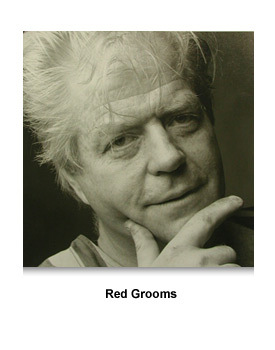

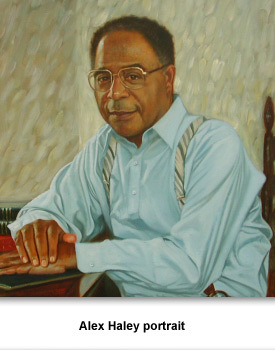
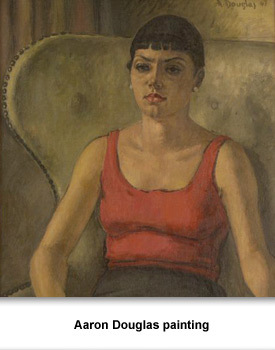
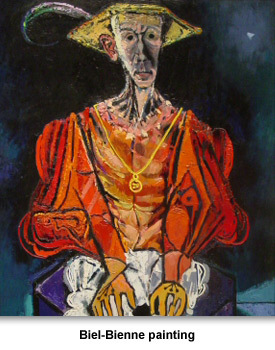

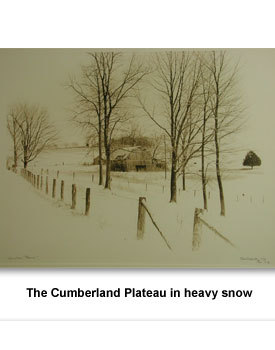
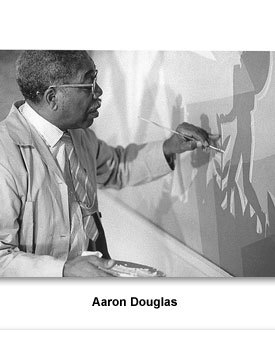
 Sponsored by: National Endowment for the Humanities
Sponsored by: National Endowment for the Humanities